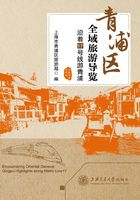
青浦区概览 The Introduction of Qingpu District
青浦区地处上海市西部、黄浦江上游,是上海市唯一一个同时接壤江苏和浙江的行政区,是上海市的门户之地,也是长江三角洲经济圈中心地带,背靠虹桥综合交通枢纽,境内河流纵横交错,湖泊星罗棋布,水路交通便捷。青浦地形东西两翼宽阔,中心区域狭长,形如展翅飞翔的蝴蝶,区域面积668.54平方千米,位列上海市第四位。
青浦区历史悠久,7000年前已经成陆地,6000年前已有先民居住,他们在这块土地上劳动、生息、繁衍,创造了灿烂的古代文化。“崧泽文化”是太湖地区新石器时代具有一定典型代表性的原始社会文化,断定青浦地区是上海迄今为止发现的人类最早的聚居地,因此青浦被称为“上海之源”。明嘉靖二十一年(1542),建制青浦县。1999年9月,经国务院批准,青浦撤县建区。
青浦区环境秀丽、生态良好,被国家环保部命名为“国家环境保护模范城区”“国家生态区”。全区水域面积112.19平方千米,占区域总面积的18.1%。上海市最大的21个天然湖泊全部汇聚于此,最大的天然淡水湖泊——淀山湖面积达62平方千米;朱家角古镇、青西郊野公园和淀山湖等都是上海知名的旅游景点。

“三大两高一特色”是青浦区主导产业体系。“三大”是指不断做强大物流、大会展、大商贸三大现代服务业产业集群;“两高”是指重点发展高端信息技术、高端智能装备两大先进制造业产业集群;“一特色”是指加快发展健康休闲产业,力争形成3到5个千亿级产业集群,建成国家全域旅游示范区。
青浦区致力于打造“绿色青浦,上善之城”。根据《上海市城市总体规划(2016—2040)》,首次将沪湖通道纳入上海市战略布局的五大骨干廊道之一。随着长三角一体化发展的深化、上海市城市功能布局的调整、重大产业平台和交通枢纽设施的建设,青浦区位优势和生态优势日益显现。
青浦区的发展目标是要提高城乡发展一体化综合水平,打造上海对外服务的门户城区和长三角一体化发展的综合性节点城区,全面建设生态宜居的现代化新青浦和人民群众幸福美好的新生活。
☆ ☆ ☆
Located in the western suburbs of Shanghai, the upper reaches of the Huangpu River, Qingpu District is the only administrative district in Shanghai which borders on both Jiangsu and Zhejiang Provinces. As Shanghai’s western portal into Chinese Mainland, it is at the center of China’s economically dynamic Yangtze River Delta Region (the Yangtze River Delta). Backed by Hongqiao Transportation Hub and crisscrossed lakes and rivers within the district, it boasts the well-developed ground and water transportation networks. Like a butterf ly, Qingpu District is narrow in the central area, and wide in its eastern and western wings. The total area covers 668.54 square kilometers, ranking as the fourth largest district in Shanghai.
With a long history, Qingpu District shaped into land about 7,000 years ago, and was inhabited by its ancestors 6,000 years ago. They labored and lived on this land, giving birth to a gorgeous ancient civilization. Qingpu District housed the earliest human habitats in Shanghai thanks to the Songze Culture — a typical ancient culture during the Neolithic Period in Taihu Lake Area. Hence, Qingpu was regarded as “the Origin of Shanghai”. Qingpu County was established in 1542 (the 21st year of Emperor Jiajing of the Ming Dynasty). In September 1999, instead of Qingpu County, Qingpu District was set up upon approval by the State Council.
Thanks to the advantageous ecological environment, it was named “Excellent District for National Environmental Protection” and “National Ecological Area” by the Ministry of Environmental Protection. The water area of Qingpu District covers 112.19 square kilometers and 18.1% of the district’s total. Among 21 natural lakes, Dianshanhu Lake is the largest freshwater lake with an area of 62 square kilometers. Numerous famous scenic spots around include Zhujiajiao Ancient Town, Qingxi Country Park, Dianshanhu Lake and so on.
The leading industrial system in Qingpu District is as follows: steadily strengthen three big modern service industry clusters including logistics, exhibitions and trades; focus on the development of two high-end advanced manufacturing industry clusters including information technology and intelligent equipment advanced manufacturing industry clusters; accelerate one distinctive industry — health and leisure industry, aiming to establish three to f ive billion-yuan industrial clusters and become the national all-round tourism demonstration area.
According to Shanghai Master Plan (2016—2040), Shanghai-Huzhou Corridor was f irst incorporated into one of the f ive main corridors of Shanghai’s strategic layout. With the further integrated development of the Yangtze River Delta, the adjustment of Shanghai’s functional layout, the construction of major industrial platforms and transportation hub, Qingpu District enjoys more remarkable regional and ecological advantages.
Qingpu District is aiming to improve the integration of urban and rural development, to be a comprehensive node city for Shanghai’s outward service and the integration of the Yangtze River Delta and to build an ecological and liveable modern new Qingpu for a happier life.